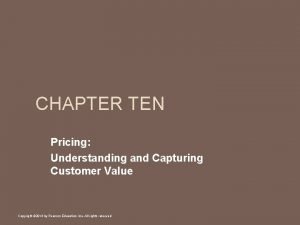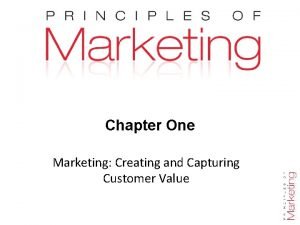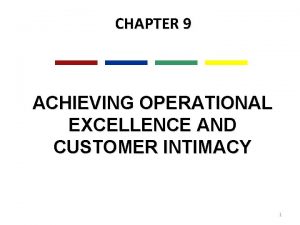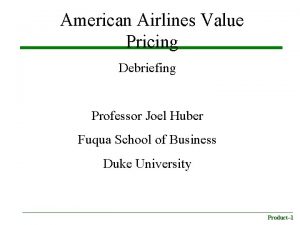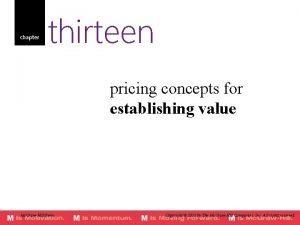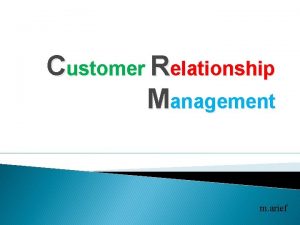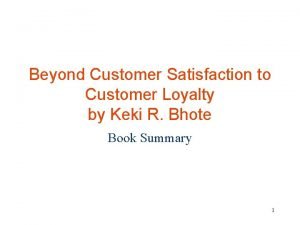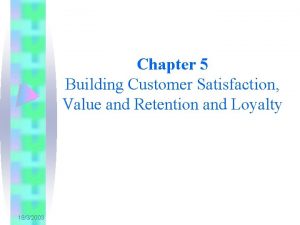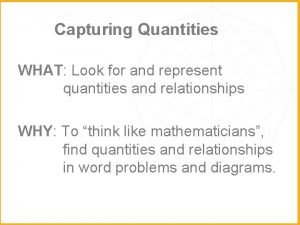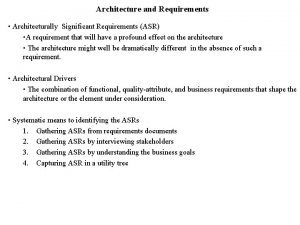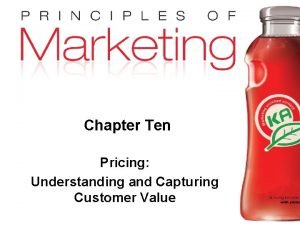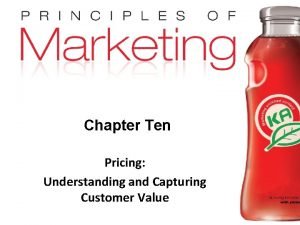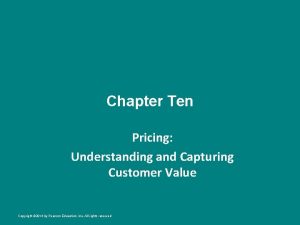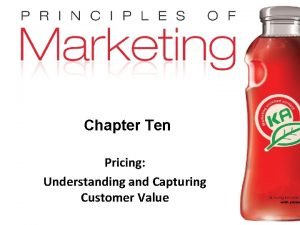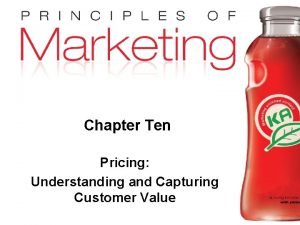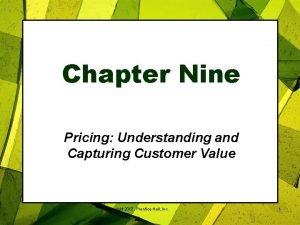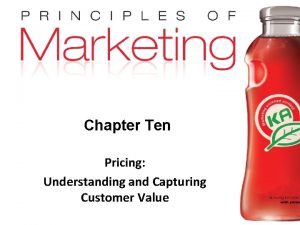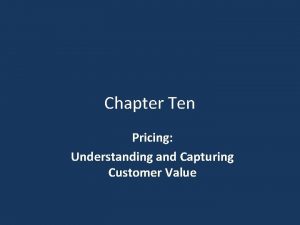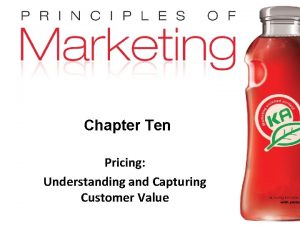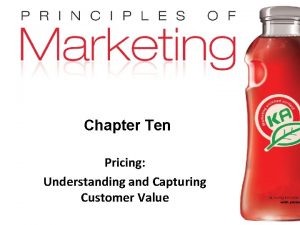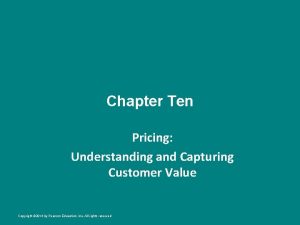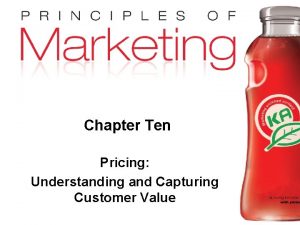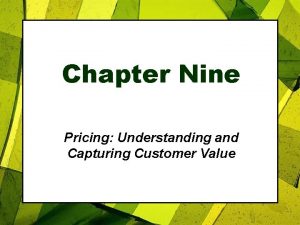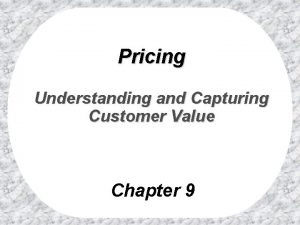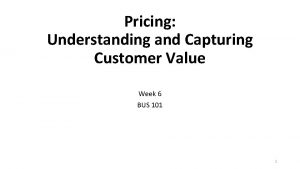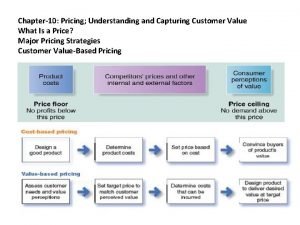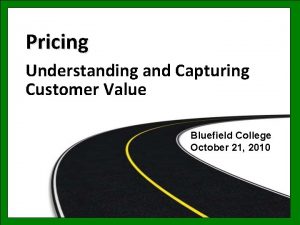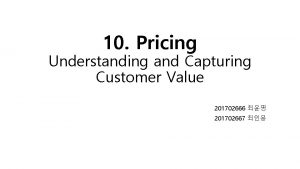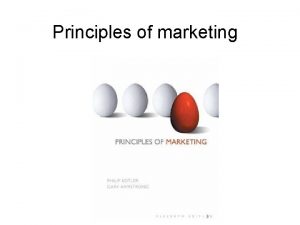PRICING UNDERSTANDING AND CAPTURING CUSTOMER VALUE 1 Chapter






































- Slides: 38

PRICING UNDERSTANDING AND CAPTURING CUSTOMER VALUE 1 Chapter 9

WHAT IS A PRICE? o Narrowly defined, price is the amount of money charged for a product or service. o Broadly defined, price is the sum of all the values that customers give up in order to gain the benefits of having or using a product or service. o Price is the only element in the marketing mix that produces revenue. o Price ric is one of the most flexible marketing mix elements. 9 -2

PRICE VS. VALUE Cutting cost in tough economic times is not always the answer. Companies should sell value, value not price Price reductions can: • • Cut profits and initiate price wars. Cheapen perceptions of brand quality. Marketers should strive to convince consumers that price is justified by value provided. Question: Do you think of the value when you buy? And why? 9 -3

MAJOR PRICING STRATEGIES 1. Perceived value-based pricing: Setting prices based on buyers’ perceptions of value rather than the seller’s cost. 2. Cost-based pricing: Setting prices based on the actual cost of producing, distributing, and selling product at a targeted rate of return. 3. Competition-based pricing: Setting prices based on competitors’ strategies, costs, prices, and market offerings. 9 -4

FIGURE 9. 1 - CONSIDERATIONS IN SETTING PRICE 9 -5

1 - PERCEIVED VALUE-BASED PRICING Price is considered along with the other marketing mix variables before the marketing program is set. • • Customer needs and value perceptions are assessed. Target price is based on value perception. “Good value” is certainly not the same as “low price. ” 9 -6

CUSTOMER VALUE-BASED PRICING • • Setting price based on buyers’ perceptions of value rather than on the seller’s cost Types: • Good value pricing • Value-added pricing A Steinway piano—any Steinway piano—costs a lot. But to those who own one, price is nothing; the Steinway experience is everything 9 -7

FIGURE 9. 2: VALUE-BASED PRICING VS. COST-BASED PRICING 9 -8

GOOD-VALUE PRICING • Offering the right combination of quality and good service at a fair price With its no-frills positioning and low prices, Snap Fitness is well-positioned to take advantage of either good or bad economic conditions 9 -9

VALUE-ADDED PRICING • Attaching value-added features and services to differentiate a company’s offers while charging higher prices Rather than cutting services to maintain lower admission prices, premium theaters such as AMC’s Cinema Suites are adding amenities and charging more. 910

2 - COST-BASED PRICING Cost-based pricing: Setting prices based on the costs for producing, distributing, and selling the product plus a fair rate of return for effort and risk Types of costs: Fixed costs: (also known as overhead) are costs that do not vary with production or sales level. Variable costs: vary directly with the level of production (vary with the number of units produced). Total costs: are the sum of the fixed and variable costs for any given level of production. 911

TYPES OF COST-BASED PRICING Typically, there are two types of cost-based pricing: 1. Cost-plus (markup) pricing: Adding a standard markup to the cost of the product. ü Markup pricing remains popular because: § § Sellers are more certain about costs than about demand. When all firms in the industry use this method, prices tend to be similar and price competition is thus minimized. 2. Break-even pricing (or a variation called Target return pricing): The firm tries to determine the price at which it will break even or make a target profit 912 9 - 12

FIGURE 9. 3: CHART FOR DETERMINING TARGET-RETURN PRICE & BREAKEVEN VOLUME 913

COMPETITION-BASED PRICING • Setting prices based on competitors’ strategies, prices, costs, and market offerings Fast-growing clothing boutique Hot Mama isn’t likely to win a price war against giants like Macy’s or Kohl’s. Instead, it relies on personal service, a mom- and kid-friendly atmosphere, and its knowledgeable staff to turn 9 14 harried moms into loyal patrons

3 - COMPETITION-BASED PRICING Assumption: Competition-Based Pricing assumes that consumers base their judgments of a product’s value on the prices charged by competitors for similar products. Requirements: Competition-Based Pricing requires full assessment of competitors’ pricing strategies. The following questions must be answered: How does the firm’s offering compare in terms of customer value? ü How strong are competitors? ü What are their pricing strategies? ü What principle should guide pricing decisions relative to those of the 9 competition? 15 ü

FACTORS AFFECTING PRICING DECISIONS Customer perceptions of value: ü Product costs: ü • • • No demand exists above price ceiling (upper limit in a price range). No profit exists below price floor (lower limit in a price range). Company must decide on its overall marketing strategy for the product and the role that price will play in accomplishing objectives Pricing decisions need to be coordinated with packaging, promotion, and distribution decisions Positioning may be based on price 916

INTERNAL FACTORS AFFECTING PRICING DECISIONS (1) Overall marketing strategy, objectives, and the marketing mix: § Company must decide on the role the price will play in accomplishing marketing objectives and strategy. § Pricing decisions need to be coordinated with other marketing mix elements (product, promotion, distribution). For example, ü Product positioning may be based on price. (2) Organizational considerations: § It must be clear who, within the organization, should set prices. § This will vary depending on the size and type of company. § Some firms maintain pricing departments (which is specialized in setting prices). 917

EXTERNAL FACTORS AFFECTING PRICING DECISIONS (1) The market and demand: üA firm’s flexibility in setting price varies depending on the nature of the market. üFour types of markets exist: 1. Pure competition. 2. Monopolistic competition. 3. Oligopolistic competition. 4. Pure monopoly. üAnalyzing the price-demand relationship: § Different prices result in different levels of demand, as shown by the demand curve. ü Price elasticity of demand: § Refers to how responsive changes in demand will be to a change in price. v If demand hardly changes with a small change in price, 9 demand is inelastic. While, 18 v If demand changes greatly with a small change in price, demand is elastic.

THE MARKET AND DEMAND • • A firm’s flexibility in setting price varies depending on the nature of the market Types of markets: • Pure competition: the market consists of many buyers and sellers trading in a uniform commodity. No single buyer or seller has much effect on the ongoing market price. • Monopolistic competition : • Oligopolistic competition : the market consist of only a few large the market consist of many buyers and sellers who trade over a range of prices rather than a single market price. sellers. Each seller is alert and responsive to competitors pricing strategies and marketing moves. • Pure monopoly : the market is dominated by one seller. The seller may be a Govt. monopoly, a private regulated monopoly or a private unregulated. Pricing is handled differently in each case. 919

DEMAND CURVE • Ø Shows the number of units the market will buy in a given time period, at different prices that might be charged Price Elasticity: how responsive demand will be to a change in price. 920

EXTERNAL FACTORS AFFECTING PRICING DECISIONS (CONT’D) (2) The economy: § Economic factors have a strong impact on pricing strategies. § The recent recession has led to many consumers becoming more value-conscious. § While some firms have cut prices, others have shifted to more affordable items in the market. § Some firms have held price, but repositioned brands to enhance their value. (3) Other external factors: § Governmental reaction or pricing controls. § Social concerns (e. g. prices of basic food and medicine should be reasonably low in most societies). 921

NEW-PRODUCT PRICING STRATEGIES Market skimming: Setting a high price for a new product to “skim” revenues layer -by-layer from those willing to pay the high price. Company makes fewer, but more profitable sales When to use: Product’s quality and image must support its higher price. Cost of smaller volume can not be so high that they cancel the advantage of charging more. Competitors should not be able to enter market easily 922

NEW-PRODUCT PRICING STRATEGIES Market penetration: Setting a low initial price in order to penetrate the market quickly and deeply. Can attract a large number of buyers quickly and win a large market share When to use: Market is highly pricesensitive so a low price produces more growth. Production and distribution costs must decrease as sales volume increases Low price must help keep out the competition. 923 9 - 23

PRODUCT MIX PRICING STRATEGIES Product-line pricing: Ø Setting price steps between various products in a product line based on cost differences between products, customer evaluations of different features, and competitors’ prices. Optional-product pricing: Ø Pricing optional or accessory products sold with the main product (e. g. , ice maker with the refrigerator). 924 9 - 24

PRODUCT MIX PRICING STRATEGIES (CONT’D) Captive-product pricing: Ø Pricing products that must be used with the main product (e. g. , replacement cartridges for Gillette razors). By-product pricing: Ø Pricing by-products (by‑products produced in the generation of some products and services. ) in order to make the main product’s price more attractive Product bundle pricing: Ø Combining several products and offering the bundle at a reduced price (e. g. , fast food combo meals). 925 9 - 25

TABLE 9. 1: PRODUCT MIX PRICING 926

PRICE ADJUSTMENT STRATEGIES ►Discount and allowance pricing. ►Segmented pricing. ►Psychological pricing. ►Promotional pricing. ►Geographical pricing. ►Dynamic pricing. ►International pricing. See next slides for details… 927 9 - 27

TABLE 9. 2: PRICE ADJUSTMENTS 928

PRICE ADJUSTMENT STRATEGIES: DISCOUNT AND ALLOWANCE PRICING Discounts: v Cash discount, a price reduction to buyers who pay promptly. v Quantity discount, a price reduction to buyers who buy large volumes. v Functional discount (also called a trade discount), is offered to channel members who perform certain functions. v Seasonal discount, a price reduction to buyers who buy merchandise or services out of season. Allowances: Trade‑in allowances are price reductions given for turning in an old item when buying a new one. v Promotional allowances are payments or price reductions to reward dealers for participating in advertising and sales support programs. v 929 9 - 29

PRICE ADJUSTMENT STRATEGIES: SEGMENTED PRICING Segmented pricing: Selling a product at different prices to account for differences in customers, products locations (the difference in prices is not based on differences in costs). costs Types: 1. Customer-segment pricing: different customers in different segments pay different prices for the same product. 2. Product‑form pricing: Different versions of a product are priced differently (but not according to differences in costs). 3. Location pricing: different prices for different locations, even though the cost in each location is the same). 4. Time pricing: A firm varies its price by the season, month, and even the day/hour (cost is the same). 930 9 - 30

PRICE ADJUSTMENT STRATEGIES: PSYCHOLOGICAL PRICING Psychological pricing: considers the psychology of prices and not simply the economics ü Price is used to say something about product. ü Price can often influence perceptions of quality. ü Reference prices are important (prices that buyers hold in their minds and refer to when looking at a given product). product 931 9 - 31

PRICE ADJUSTMENT STRATEGIES: PROMOTIONAL PRICING Promotional pricing: companies temporarily price their products below list price and sometimes even below cost to create buying excitement and urgency. Promotional pricing may take several forms, forms such as: Special‑event pricing: Pricing differently in certain seasons to draw more customers. Cash rebates: Consumers, who qualify for the rebate, are entitled to a cash refund directly from the manufacturer. Promotional pricing can have adverse effects. Price promotions can create “deal-prone” customers who wait until brands go on sale before buying them. Constantly reduced prices can erode a brand’s value in the eyes of customers. Promotional pricing can lead to industry price wars. 932

PRICE ADJUSTMENT STRATEGIES: GEOGRAPHICAL PRICING Geographical Pricing is pricing a products for customers located in Types: different geographic locations. FOB-origin pricing: The goods are placed free on board (hence, FOB) a carrier. At the point where FOB is indicated, the title and full responsibility for the goods pass to the buyer. ► Uniform-delivered pricing: Here, the company charges the same price plus freight to all customers, regardless of their locations. ► Zone pricing: All customers within a given zone pay a single total price; the more distant the zone, the higher the price, and vice versa. ► Basing-point pricing: The seller selects a given city as a “base-point” and charges all customers the freight cost from that city to the customer location, regardless of the city from which the goods are actually shipped. ► Freight-absorption pricing. The seller absorbs all or part of the actual freight charges in order to get a desired business. ► 933

PRICE ADJUSTMENT STRATEGIES: DYNAMIC PRICING Dynamic Pricing is adjusting prices continually to meet the characteristics and needs of individual customers and situations. Dynamic pricing offers many advantages: advantages Internet sellers can instantaneously tailor products to fit that E-shopper’s behavior, and price products accordingly. ü Internet buyers have access to a wealth of price comparison sites, thus dynamic price is necessary. ü Buyers can also negotiate prices at online auction sites and exchanges. ü 934

PRICE ADJUSTMENT STRATEGIES: INTERNATIONAL PRICING International Pricing: The price that a company should charge in a specific country depends on many factors, including: including ►Economic conditions. ►Competitive situations. ►Laws and regulations. ►Development of the wholesaling and retailing system. ►Consumer perceptions and preferences. ►Different marketing objectives. ►Costs. 935

PRICE CHANGES Price Cuts: Several situations may lead a firm to consider cutting its price. Excess capacity. Falling demand in the face of strong price competition. Desire to dominate market through lower costs. Price Increases: Price increase may be initiated due to: Cost inflation. Over-demand. Buyer Reactions to Price Changes: Customers often view price cut positively, while look at price increase unfavorably Competitor Reactions to Price Changes: Competitors are most likely to react when: ü the number of firms involved is small ü when the product is uniform ü when buyers are well informed about products and prices. 936

PRICE CHANGES: FIRM REACTIONS TO PRICE CHANGES BY COMPETITION The firm needs to answer some questions before reacting to price changes by competitors: ü Why did the competitor change the price? ü Is the price change temporary or permanent? ü What will happen to the firm’s market share and profits if it does not respond? ü Are other competitors going to respond? To deal with competitor’s price cuts, cuts a company could: Ø Reduce its price to match a competitor’s price. Ø Maintain its price but raise the perceived value of its offer. Ø Improve quality and increase price, moving its brand into a higher pricevalue position. Ø Launch a low‑price “fighting brand” (adding a lower‑price item to the line or creating a separate lower‑price brand). 937

PUBLIC POLICY AND PRICING Major public policy issues in pricing, which often raise legal concerns: ► Price-fixing: coordinating with competitors to manipulate price. ► Predatory pricing: selling below cost with the intention of punishing a competitor or gaining higher long-run profits by putting competitors out of business. ► Price discrimination: using different prices for the same product in the target market. ► Retail (or Resale) price maintenance: occurs when a manufacturer requires dealers to charge a specified retail price for its product (RRP). ► Deceptive pricing occurs when a seller states prices or price savings that mislead consumers or are not actually available to consumers. 938
 Pricing understanding and capturing customer value
Pricing understanding and capturing customer value Creating and capturing customer value
Creating and capturing customer value Marketing concept
Marketing concept Marketing creating and capturing customer value
Marketing creating and capturing customer value Creating and capturing value
Creating and capturing value Capuring
Capuring Measuring sources of brand equity
Measuring sources of brand equity Value creation value delivery value capture
Value creation value delivery value capture How channel members add value
How channel members add value Customer relationship management and customer intimacy
Customer relationship management and customer intimacy Customer relationship management and customer intimacy
Customer relationship management and customer intimacy Customer relationship management and customer intimacy
Customer relationship management and customer intimacy Building and delivering customer value and satisfaction
Building and delivering customer value and satisfaction American airlines value pricing
American airlines value pricing Pricing concepts for establishing value
Pricing concepts for establishing value Managing customer information to gain customer insights
Managing customer information to gain customer insights Pengertian customer relationship
Pengertian customer relationship Beyond customer satisfaction
Beyond customer satisfaction Chapter 1 marketing
Chapter 1 marketing Product lines
Product lines How to build customer satisfaction value and retention
How to build customer satisfaction value and retention What is customer value satisfaction and loyalty
What is customer value satisfaction and loyalty Creating customer value satisfaction and loyalty
Creating customer value satisfaction and loyalty Building customer satisfaction value and retention
Building customer satisfaction value and retention Creating customer value satisfaction and loyalty
Creating customer value satisfaction and loyalty Customer satisfaction value and retention
Customer satisfaction value and retention What is customer value satisfaction and loyalty
What is customer value satisfaction and loyalty What are the basic guidelines of value education?
What are the basic guidelines of value education? Capturing kids hearts four questions
Capturing kids hearts four questions Kevin kotler net worth
Kevin kotler net worth Capturing kids hearts four questions
Capturing kids hearts four questions A device used for capturing images
A device used for capturing images Capturing reality documentary
Capturing reality documentary Capturing quantities
Capturing quantities Capturing quantities
Capturing quantities Example of data capturing
Example of data capturing Asr architecture
Asr architecture Capturing quantities
Capturing quantities Local exhaust ventilation definition
Local exhaust ventilation definition
